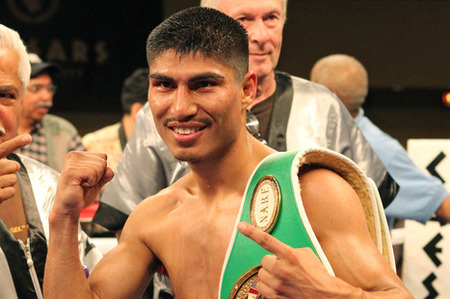
Considering the fact that many boxing fans are happy to offer their opinions as to who they should face next, it would make management of a prospect seem easy, thus completely overlooking the extensive deliberation when it comes to matchmaking. Due to the assortment of variables at hand, building up a fighter is a very delicate task. Not only must the boxer’s abilities be developed, but also his brand. After all, the promoter takes a considerable risk when choosing to sign a prospect to their stable, as unlike with established fighters who are already known to a wider audience, an investment in a prospect may not yield any financial returns for a long time.
The single most important factor is identifying how good a prospect is and how much potential he likely has. Once this has been determined, a primary task of the promoter is to sell the product. The hype campaign begins and attempts are made to make fans think that the prospect is going to be successful and/or is better than he actually is. Such a pursuit is best achieved by making the prospect look strong against over-matched opposition, although a balance ought to be struck given that a prospect will not learn much from fights where he dominates at will. If a prospect’s isn’t gradually stepping up in the level of competition he faces, it’s almost always a tell-tale sign that either the promoter isn’t up to the task of guiding the prospect, or that the team are of the understanding that the prospect just isn’t a viable long-term project. For example, prospect X is lacking in natural punching power, has limited punching resistance, and his technical skills aren’t developing. In this case, the prospect is unlikely to achieve any accolades in the sport and his opponents are carefully selected to ensure that they are technically limited (more so than the prospect), lacking in durability, as well as lacking in punching power so as to not expose the prospect’s chin.
Ideally for his promoter and everyone concerned, prospect X will build up a lengthy undefeated record before securing a lucrative payday. The prospect loses his ’0′, and attempts are usually made to repeat the process until the boxer ceases to generate enough interest among the public. At this point, prospect X will typically leave the sport and consider it to have been a worthwhile venture, or in some cases, may become a journeyman taking whatever fights he can if the purse on offer is deemed good enough. Much depends on the peak of the status reached by the prospect.
What about a genuine case where a prospect has good potential, a good coaching setup, as well as a promoter who is up to the task of ensuring that they develop into the best that they can be, both as boxer and as a commodity? This is the prospect that will be matched with better opponents over time. His 10th opponent will be significantly better than what was put in front of him for his debut, and by the time he’s had 15-20 fights, he has beaten a few reputable opponents that are known to avid fans of the sport and who even the casual fan might have heard of. On his journey, the prospect will have boxed a variety of opponents, all offering something for the prospect to test the prospect. For example, somewhere on a prospect’s record you will often find a southpaw journeyman. This is an important experience for the prospect due to the awkward angles presented by the stance of a left-handed opponent. The prospect learns how to step inside against a southpaw, when he is himself open to an opponent’s left cross, the importance of circling to a southpaw’s right (or to the left is his power isn’t respected), as well as how a southpaw can be “blind” to a well-timed left hook.
Also found on the prospect’s record are opponents who are known only for their ability to take punishment. These are often called “survivor” journeyman, with their durability being ideal for a prospect to develop their repertoire of shots. In an ideal world these opponents will be stopped within the scheduled distance at some point (in order to further the boxer’s brand), unless the boxer intentionally needs rounds, such as when getting used to fighting in 6, 8, 10, and 12 rounders. By virtue of the fact that these boxers are little more than human punching bags in practice, to be matched with too many of them does not prepare a prospect for competitive fights at a higher level.

In order for a prospect to be ready for “live” opponents, it is essential that he has some fights which adequately test his skills and attributes. This is where promoters can be innovative in their approach as the types of opponents used will have at least one strength, but also some blatant limitations. For example, an opponent from a lower weight class who will be out of his depth, perhaps technically or due to the fact they’re suspect to a hard shot. From this type of fight, the prospect learns to cope with hand speed and lateral movement that are superior to his own, a lesson which will put him in good stead later in his career. Likewise, a technically sound boxer with a stamina problem would give the prospect closely contested rounds before fading later on. The same could be said of a naturally heavy-handed opponent who perhaps lacks the skill, technique and conditioning to truly trouble the prospect, but it still gives him something to think about, even if he is taking hard shots on the gloves.
Last but not least, it is imperative that a prospect is comfortable executing a game plan against an opponent who has more height and reach. The prospect needs to be to be adept at jabbing-in, slipping shots from the outside, and using his superior angles on the inside against the taller opponent. It should be noted that sparring these aforementioned types of boxers is no substitute for real experience.
In addition to ensuring that the prospect is learning from his fights, the importance of building up a prospect’s profile can’t be understated. In order to further promote the idea that the prospect is on his way, he must be get ‘names’ on his record. This is usually an ex-contender who still has some sort of status, both in the sport and in terms of public opinion. This helps generate more interest in the prospect. Interviews and public appearances are also helpful in this regard given that the prospect may then come across as likable, thus making people more likely to buy ringside tickets and/or PPV access for their fights in the future. Both the promoter and the prospect understand the need to appeal to the public if they are to make money.

When the time comes to match a prospect against a rival or a dangerous opponent who has a chance to actually win, the prospect’s management must give due assessment to risk and reward. In some cases the financial return may be too tempting and the prospect can easily be rebuilt should he lose. It’s also possible that the consequences of defeat may be too dire to contemplate, however, such as in the event of the prospect being relegated to irrelevancy if he doesn’t have much of a public profile or status in the sport to salvage. Often entwined with this are the risky dynamics of purse bids, an arrangement which may either be agreed upon by two promoters or made compulsory by a sanctioning body. In this scenario, promoters of both fighters (as well as those not affiliated) may be invited to submit bids to promote a fight. If a promoter bids too high, he runs the risk of paying over the odds for a fight. From the other angle, if a promoter doesn’t come out on top in purse bids, his fighter will have to box on another promoter’s card, and possibly even on a rival TV channel.
Even in open pre-fight negotiations where purse bids are not called for, TV channels and promoters alike often insist on ‘options’ to protest their investment. In other words, they may instance on contractual obligations where the other boxer will have x fights for that promoter / on that TV channel if he beats their man. Boxing politics is as ugly as it is cut-throat, but it’s something every prospect of note will inevitably be submerged in to some degree. It’s also the main reason for prospects of the same weight class being kept apart until later when interest in them fighting is as its peak, such as when a title is on the line, or when the both boxers have developed enough of a following for their meeting to make sense for all concerned.




